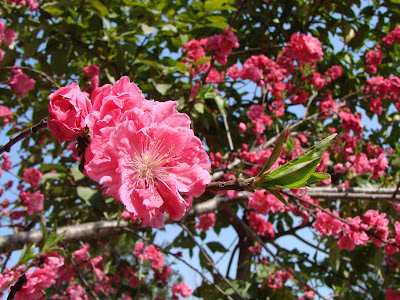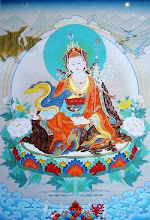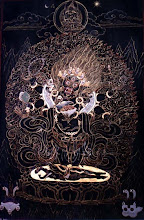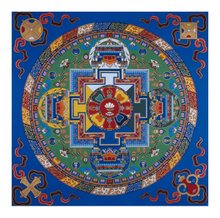Monday, March 26, 2007
Where to now?
Obviously, if you've been following the blog, you've seen that I've learned a few rudimentary drawing and painting skills, and in regard to these I have done better than I expected. Sitting daily for two three-hour sessions, I had a chance to let my mind settle and to practice patience and concentration. These qualities were also developed partly through daily mediation, a rediscovered practiced that blossomed alongside a reawakened interest in Buddhism.
So where does all this lead?
Practically speaking I've learned that it may take 2-3 years of regular practice to become a decent painter, after which I can spend the rest of my life refining my skills and learning more about the philosophy behind the iconography.
While it seems unlikely I'll ever make much money as a thangka painter, there are other rewards, including those that I've already mentioned - slowing down the mind, developing concentration and patience, and a deeper understanding of Buddhist philosophy and meditation practice. There is also the very real possibility of developing a whole new network of relationships with artists, many of whom work many years within the Buddhist community painting thangkas, statues, temples, and other artefacts associated with practice of Buddhism.
For the moment I think those are worthy aspirations. I'd like to continue to develop my art skills, but the question then becomes how to do that.
Among the ideas I've been mulling over is to take a leave of absence for the fall semester and return here to study for the period from Sept/Oct through to this time next year, March 2008. That would allow me to complete the core 1st year program at Shechen and establish a very solid base, after which time I could reevaluate my development and interest in continuing.
Another is to enter the arts program at Naropa, the only accredited Buddhist university in North America. Here I could study thangka and earn a certificate or another bachelor's. It appears, though, that the cost may be prohibitive.
Still another is to bring a teacher to me, rather than me running across the world to the teacher. If I can find a few people in the Fukuoka area interested in studying thangka, it may be possible to sponsor an artist to come and live in Japan.
It goes without saying that any decision will be made in consultation with Mutsumi, whom I've missed a great deal while I've been away. I think she's missed me, too, but I'll let her be the one to tell you that. It seems she's been quite busy with her own projects and has acquired some new confidence and interest in pursuing some of her own interests, which I'm hoping to learn more about on my return.
I feel now like the future holds great possibility for new directions for both Mutsumi and I. I'm looking forward to exploring those with her and, where appropriate, sharing them with you.
You might also be interested to know that in addition to all this, I've lost as well as gained - 3 kilos and 2 notches on my belt.
#
We know what we're not

#
Blood sacrifice . . .
#
Friday, March 23, 2007
My amazing day in Kathmandu
She also mentioned a gallery in Thamel, the tourist area of the city, that sells his work and when I was down in that area yesterday I happened to run across it. Wasn't looking for it, just passed by it and saw some interesting work on display and when I checked the name of the artist - it was Tenzin. So I go in and look at some more work and talk to the sales clerk a bit and when he finds I'm staying in the same area where he himself lives, and where Tenzin lives, he asks if I'd like to meet him.
So we met this morning at 7:00 and walked over to Tenzin's house. His wife served tea and we sat around and chatted for an hour or so. Got to see a number of paintings and had the opportunity to talk to him about the possibility of introducing his work into Japan. And I also found out that the anthropologist is the writer of this children's book project on which they collaborated:
Clear Sky, Red Earth
I returned to my guesthouse and called Sundar Shrestha, the producer of a locally recorded cd. I had found his music at a cd shop - and his email on his cd - and had written to see if he might like to sell his cd at CDJam. We met up for coffee to discuss CDJam and in the process I find out he's the exclusive distributor in Nepal for a number of recording equipment manufacturers and has himself helped set up more than 100 recording studios in Kathmandu. I mentioned that besides my cd shop and radio show, I also do a bit of voice work in Japan and ask if he can't introduce me to someone who might help me get a little work here.
The more we talked the more ideas started to percolate. He drove me over to meet DJ Santosh, who is supposed to be the hot remixer in Kathmandu and we did a little bit of recording with the idea of producing a demo cd that Sundar can shop around to radio, tv, and film producers. When I finally got back home late this afternoon, I confirmed that Santosh is indeed what he claims to be. I asked a young man who has a music shop here in Boudha, a guy whom I've spoken to on many days while walking through town, if he knew DJ Santosh, which generated a are-you-kidding? reply.
Santosh has invited me back to the studio to do a little more work with some music he's mixing now. If time permits, I hope to do so.
Besides having the chance to meet all these amazing people in one day, and to meet them without first knowing who they were or without any idea of meeting them, has been quite a high, which has been kicked into even higher gear by talk of all the possibilities of future projects and collaborations.
Maybe the most amazing day I've yet had in Kathmandu.
#
Thursday, March 22, 2007
Exams

The past three days have been exams at art school. As I've just arrived, I didn't sit for them, though I did go to school one last time yesterday to savor for the last time a bit of the atmosphere.
It was sad to sit at prayers without getting choked up thinking that I might not see this group of people together again for some time, some of them perhaps never again as they will graduate or go on to other things.
I also had to say goodbye to Thomas, a Belgian traveler staying at my guest house and with whom I spent a week full of breakfasts and dinners.
Yesterday was a hard day of farewells.
#
Strike
Apparently the businessmen have called off their strike and perhaps things will return to normal. Good news for me as I have been waiting to pick up some tailoring.
Below is a shot of the local Maoists protesting on the main road in front of Boudha.
Tuesday, March 20, 2007
Book Review: Images of Enlightenment (revised); Jonathan Landaw & Andy Weber, 2006
 Images of Enlightenment is organized around 32 full-color plates, paintings by Andy Weber, a UK-based artist trained in Nepal by refugee Tibetan painters and now himself a widely traveled and respected teacher in Europe and North America. (See the artist's website for more examples of his work and his current teaching schedule.) Each chapter of the book begins with a theme, followed by explanations of the handful of paintings that best represent them. The first chapter on the life of the Buddha and the basics of Buddhist philosophy, for example, includes descriptions of paintings of the Buddha, stupas, and the Wheel of Life.
Images of Enlightenment is organized around 32 full-color plates, paintings by Andy Weber, a UK-based artist trained in Nepal by refugee Tibetan painters and now himself a widely traveled and respected teacher in Europe and North America. (See the artist's website for more examples of his work and his current teaching schedule.) Each chapter of the book begins with a theme, followed by explanations of the handful of paintings that best represent them. The first chapter on the life of the Buddha and the basics of Buddhist philosophy, for example, includes descriptions of paintings of the Buddha, stupas, and the Wheel of Life.As an introductory text, the authors cannot hope to cover the nearly 200 deities of Tibetan Buddhism. They manage, though, to provide an informative, well-written, and properly illustrated volume covering some of the most popular images. If you'd like to learn more about the methods and materials used in painting thangka, you might like to see Jackson and Jackson's Tibetan Thangka Painting: Methods & Materials. The paintings used in this book, while well executed, are quite simple and not cluttered with many of the background items found in many thangka. There is, therefore, little in this book explaining many of the minor elements of Tibetan painting. For a more thorough treatment of symbolism and iconography, see Robert Beer's A Handbook of Tibetan Buddhist Symbols. If you'd like to see larger and more elaborately and finely detailed thangka, have a look at two collections in Romio Shrestha's Celestial Gallery and Goddesses of the Celestial Gallery.
Monday, March 19, 2007
Book Review: Spoke in the Wheel; Amita Kanekar, 2005
 The book opens with Upali's first chapter on the birth and early life of the young prince of an Indian ruling family, a boy known as Siddartha who will when he grows up renounce his family, kingdom, and inheritance for the life of an aesthetic, eventually becoming the enlightened one we know today as the Buddha.
The book opens with Upali's first chapter on the birth and early life of the young prince of an Indian ruling family, a boy known as Siddartha who will when he grows up renounce his family, kingdom, and inheritance for the life of an aesthetic, eventually becoming the enlightened one we know today as the Buddha.Between the chapters on Siddartha's life are chapters on Upali, conscripted by Emperor Asok to compose the first biography of the Buddha. A late convert to religion, Asok was responsible for spreading Buddhism across a large part of Asia and even into parts of Europe, but only after leading campaigns of conquest, imperial adventures that created an empire spanning nearly all of current India, Pakistan, Afghanistan and parts of Iran. Among those conquests was Upali's kingdom, a genocidal campaign that has left the monk scibner with an abiding contempt for his emperor and patron.
The chapters on Upali are hit and miss. The more interesting ones detail the theological and historiographical issues facing the monk as he attempts to piece together a biography from material that was intended to preserve the essence of the teachings, and not the details of history. The less interesting chapters follow Upali's efforts to act as matchmaker between caste-crossed lovers, and the investigation of a monk's murder.
Still, this is a book worth the time and money if only to explore some of the issues involved in trying to sort out the historical from the mythological Buddha. Upali argues, for example, that the story of Siddartha's home leaving is far-fetched. As typically presented, the young prince leads a sheltered life, protected by his father from anything unpleasant. Siddartha's world is turned upside down in a matter of hours when he one day ventures out of his family's estate and witnesses poverty, sickness and death, sights that cause him to leave home that very evening in search of the meaning of life. How utterly fragile a person Siddartha would have to be, argues Upali, to have such unpleasantries cause him to run away. But even assuming he did leave home on that very same evening, its unlikely Siddartha had never been exposed to suffering. As the prince of a nation, Siddartha would have been groomed from a very early age in religious practices (which included animal sacrifices), statecraft (which involves a good measure of deceit and threat of violence), and martial arts (which on many occasions would have produced bloodletting, maiming, scarring, and even death).
Is the Buddha a god - or was he just a man? Is the purpose of his philosophy the means (leading an ethical life), or the end (enlightenment)? These and other such issues make A Spoke in the Wheel an engaging read for those interested in Buddhist or Indian history.
Saturday, March 17, 2007
Dharahara: The Bhimsen Tower


#
What I've Learned from Painting
In no particular order, here are some observations that have come to me over the past two months.
- A little color goes a long way. Apply sparingly.
- At some point you have to let go. There is no perfect painting.
- Treat your canvas like your clothes. Take great care not to spill or stain.
- There is nothing so joyous as a clean stroke.
- When painting, the world is only centimeters deep.
- A clear mind produces better work.
- The next painting will be better.
- The greatest moment of tension comes just before applying the first stroke.
- Always test your brush before applying paint.
- Never start in the center. Start on the fringes where a mistake is less likely to be noticed.
- Applying paint requires control over a number of variables: color and shade, amount of paint to water, even application, controlled movement. The best artists control all simultaneously.
#
Week 6: Tikuk

#
Wednesday, March 14, 2007
Week 6: Painting
Tuesday, March 13, 2007
Another beautiful sunset
My classmates
Week 6: Offerings of sound
Sunday, March 11, 2007
Book Review: So Close to Heaven; Barbara Crossette, 1995
 Even so this is a readable introduction to the people and history of the Buddhist cultures of the Himalayas. A first-person account of her travels through the region organized topically, former New York Times correspondent Barbara Crosette never ventures into the territory of modern travel writers to describe how the journey changes the writer. She writes instead as she would for her newspaper, with great attention to the facts of history and details of her surroundings, allowing the reader to feel immersed in this often exotic corner of the world, one that has over the last half century been slowly disappearing as development encroaches on traditional culture and as powerful neighbors usurp political independence. Unfortunately, for a reporter from such a prestigious news organization she makes little effort to investigate claims of human rights abuses against the Bhutanese monarchy, with which she admits having cordial and cozy relations.
Even so this is a readable introduction to the people and history of the Buddhist cultures of the Himalayas. A first-person account of her travels through the region organized topically, former New York Times correspondent Barbara Crosette never ventures into the territory of modern travel writers to describe how the journey changes the writer. She writes instead as she would for her newspaper, with great attention to the facts of history and details of her surroundings, allowing the reader to feel immersed in this often exotic corner of the world, one that has over the last half century been slowly disappearing as development encroaches on traditional culture and as powerful neighbors usurp political independence. Unfortunately, for a reporter from such a prestigious news organization she makes little effort to investigate claims of human rights abuses against the Bhutanese monarchy, with which she admits having cordial and cozy relations.First published in 1995, this volume remains in 2007 an interesting introduction to the region, a place slow to change and still experiencing many of the pressures and conflicts Crosette recorded a decade ago.
Saturday, March 10, 2007
Tibetan Uprising Day
I went to school this morning only to find that between yesterday afternoon, when I asked about Tibetan Uprising Day, and this morning, a holdiay was declared. I wasn't the only one who wasn't informed and a few of us who showed up for class decided to stick around and put in a few hours of practice. But as the teachers weren't around and as it was a holiday, some of the resident students made themselves comfortable in our classroom, which has the only functioning television in the building. And so our daily drawing and painting was accompanied by Hindi music videos, at least until the one girl who seemed most interested in watching them left to do something else. Then a young monk came in and took control of the remote after which it was time for classic rock videos, which I thought afterwards was quite an amusing collection of circumstances: the 45-year old American practicing Tibetan Buddhist art in a classroom in Kathmandu with a 24-year old monk from Bhutan with Bruce Springsteen singing about Glory Days.
I finally packed up and left around noon (after videos from Led Zeppelin, Mark Knopfler, Toto, and The Police, among others), did a little more painting in my room at the guest house, finished up Indestructible Truth, then headed out to the internet cafe, where along the way I snapped the following.

Free Tibet Campaign
#
Wednesday, March 7, 2007
Weeks 4 & 5
Saturday I went in to school but found it empty except for the resident students. Turns out the Tibetans like Hindu holidays as well as their own and the school was closed for Holi.
So, here today is a look at what I've been doing early this week, drawing the three jewels, kind of the Buddhist trinity, in this case a symbolic representation of Buddha (the person and teacher), darhma (the teachings), and sangha (the community).

#

































